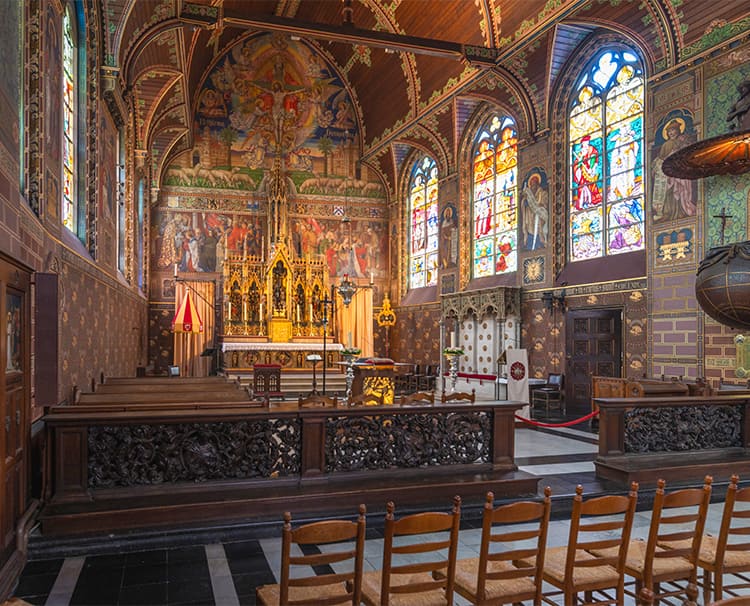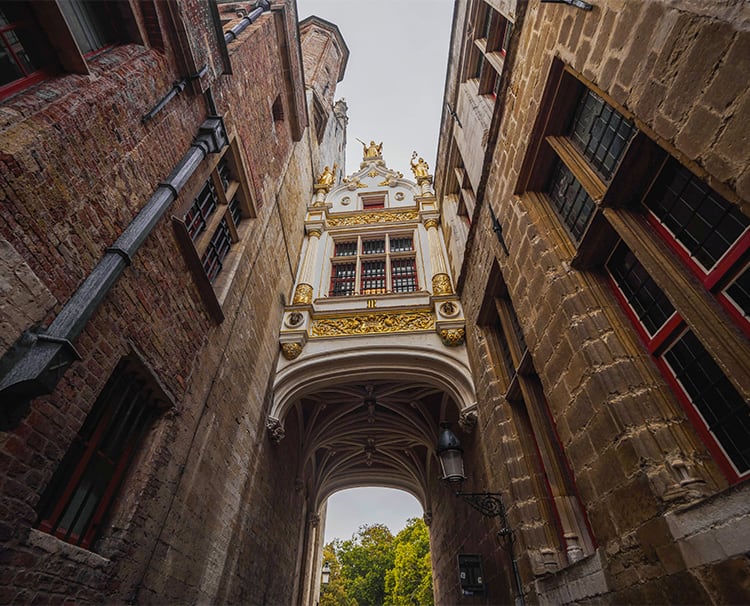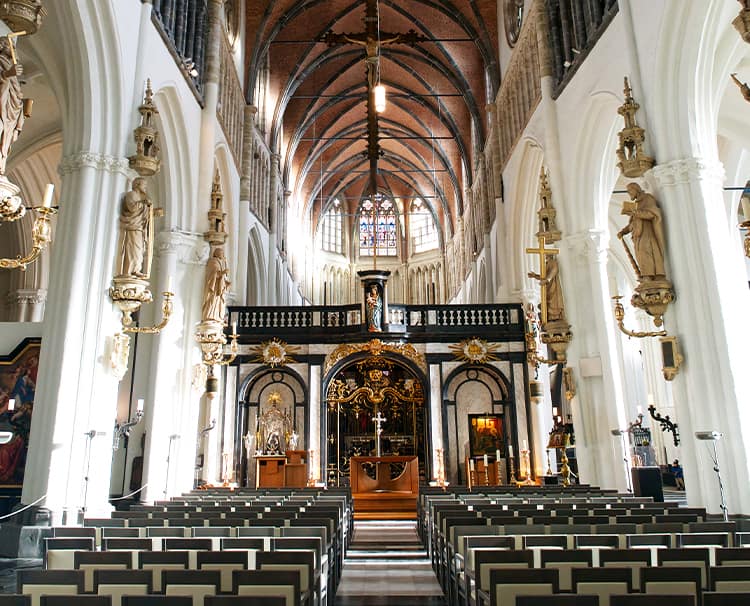Bruges, Belgium is a city steeped in history, with roots tracing back to the medieval period. This enchanting UNESCO World Heritage site brims with history: its horse-drawn carriages traversing cobblestone streets; its peaceful, winding canals; and its array of well-preserved medieval architecture. Join us on a tour of just a few of the landmarks you will get to see first-hand on our full-day excursion to this intriguing city on our Tulip Time and Best of Holland & Belgium itineraries, including the Basilica of the Holy Blood, Blind Donkey Alley, and the Church of Our Lady, each of which holds unique stories waiting to be uncovered.

Basilica of the Holy Blood: A Prized Relic Finds its Home
One of Bruges' most revered sites is the Basilica of the Holy Blood. The legend surrounding this sacred relic dates to the Crusades when Derek of Alsace, Count of Flanders, returned with a relic that set the the city ablaze in a frenzy: a towel claimed to have been used by Joseph of Arimathea to clean the body of Jesus Christ after his crucifixion.
But many historians have disavowed this version of how the relic came to Bruges. Instead, the relic is believed to have arrived in Bruges sometime in the 13th century after the fall of Constantinople, from which it may have been taken as loot.
Today, the relic is held inside the upper Basilica, a stunning Gothic chapel originally constructed in the 15th century. Behind the altar, visitors will find a wall painting depicting the legend of the arrival of the Holy Blood relic in Bruges.
The Holy Blood relic has become a symbol of faith and devotion for believers worldwide. The city comes alive with the solemn procession of the Holy Blood each spring. During this procession, citizens reenact biblical stories, paying homage to this precious artifact and reinforcing its significance as part of Bruges' cultural tapestry.

Blind Donkey Alley: A Tale of Bravery and Loyalty
The legend of Blind Donkey Alley recounts the courage and loyalty displayed by one humble donkey. This narrow alley, which sits between the Burg Square and the fish market, now stands as testament to the Bruggian character. In 1382, during the tumultuous rebellion of Ghent against the Count of Flanders, the forces from Ghent overcame Bruges at the Battle of Beverhoutsveld, seizing the city and pillaging its treasures.
Among their spoils, the gilded dragon that adorned St. Donatian's Cathedral, a symbol of Bruges' power and wealth. The Ghent warriors attempted to transport their newfound prize on a cart pulled by a Bruggian donkey. At first, the donkey obliged; however, as the group approached the city gates, the donkey defiantly refused to cross them. Perplexed and frustrated, the Ghentians decided to confuse the donkey’s sense of direction by removing its sense of sight.
Some versions of this tale suggest the warriors resorted to physically blinding the donkey, while others claim the donkey was simply blindfolded. Regardless of the method, the Ghentians ultimately won their prize, but this humble donkey's resistance became a legendary act of defiance. Thus, to honor its unwavering loyalty, the street where the brave donkey made its stand is now known as Blind Donkey Alley.

Church of Our Lady: A Towering Testament to Faith and Artistry
The Church of Our Lady stands tall with the second-highest brick tower in the world at nearly 400 feet in height. Constructed over the course of 200 years beginning in the 13th century, the soaring Gothic spires of this church dominate the Bruges skyline. This architectural marvel is not only a beacon of faith but also a treasure trove of artistic masterpieces.
Within the church's hallowed halls, you can behold the resting place of Mary of Burgundy whose exquisite tomb was crafted by a team of famed artists from the region using precious metals, a break from the traditional wood and stone used to construct previous tombs. The church is also home to Michelangelo's exquisite Madonna and Child sculpture. This serene, contemplative sculpture showcases the intersection of faith and artistic genius of Michelangelo, making it a must-see for any art history afficionado.
Beyond its standing as an artistic accomplishment, this sculpture also has a fascinating and storied past. The sculpture was purchased by a wealthy wool trader in Bruges who commissioned it as an altar piece. This made the sculpture the first by Michaelangelo to leave Italy during his lifetime. But the Madonna and Child have not remained in Belgium since first arriving in the early 16th century. The piece has left Bruges twice: first to Paris, returning only after the fall of Napoleon; and later during World War II when it was stolen by German forces and later returned by group of Allied soldiers. This latter instance is depicted in the George Clooney film, The Monuments Men.
Experience Bruges For Yourself
Bruges is a city that bears its history on its cobbled streets and in its ancient buildings. From the valiant stand of the Blind Donkey to the artistic splendor of the Church of Our Lady, each corner of this enchanting city has a story to tell.
As you wander through the winding streets of Bruges, perhaps enjoying a batch of freshly-prepared Belgian fries or a decadently sweet waffle, take a moment to revel in the stories of the city, which are not just relics of history but living threads that continue to weave the tapestry of Bruges' identity.
Join us on our full-day excursion to Bruges! Reserve your stateroom on our Tulip Time and Best of Holland & Belgium river cruises or contact your preferred travel advisor today.